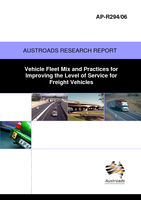Freight

- Publication no: AP-R294-06
- ISBN: 1 921139 68 4
- Published: 26 September 2006
- PDF (free) Download
This report analyses the existing vehicle fleet mix and forecast future fleet growth and reviews the appropriate indicators for the level of service for freight vehicles. It also compiles the current practices in improving the efficiency of freight vehicle movements. The freight growth was analysed with data from ABS in the period 2000 to 2004. Growth from all capital cities was found to average 2.5% per year in VKT. When light commercial vehicles were excluded, growth rates for VKT and tonne-km travelled were 0.8% and 3.0% per year respectively. Tonnage growth rates were higher than the VKT growth rates in the largest four capital cities - Sydney, Melbourne, Brisbane and Perth. It is possible that the consolidation of more freight into larger heavy vehicles may have taken place in these cities, e.g. more use of Class 9 articulated vehicles. Brisbane had both VKT and tonne-km travelled increase at about 3% per year. The growth of the urban freight task does not appear excessive but requires traffic management and other non-build measures to be planned ahead if urban congestion and freight efficiency are to be maintained. Buses, trams and emergency vehicles account for only a small percentage of the total VKT in a city. The issue for these users is not on the level of demand, but rather on the measures required to maintain and improve their level of service because of the important roles they all play in a city.
- AP-R294/06 Vehicle Fleet Mix and Practices for Improving the Level of Service for Freight Vehicles
- SUMMARY
- CONTENTS
- TABLES
- FIGURES
- 1. INTRODUCTION
- 2. CURRENT AND FUTURE VEHICLE MIX
- 2.1. Freight vehicles
- 2.2. Public transport vehicles
- 2.3. Emergency vehicles
- 2.3.1. Ambulance vehicles
- 2.3.2. Fire service vehicles
- 2.4. Taxis and high-occupancy vehicles
- 2.4.1. Taxis
- 2.4.2. High-occupancy vehicles
- 2.5. Summary on vehicle fleet mix
- 3. LEVEL OF SERVICE AND CONGESTION
- 3.1. Level of service and performance indicators
- 3.2. National Performance Indicators (NPI)
- 3.3. Performance indicators for freight users
- 3.3.1. Important performance attributes
- 3.3.2. Preferred performance indicators
- 3.3.3. Road traffic condition information
- 3.4. Summary
- 4. CURRENT PRACTICES FOR IMPROVING FREIGHT LEVELOF SERVICE
- 4.1. Land use regulations
- 4.2. Intermodal freight logistics
- 4.3. Road-based freight measures
- 4.3.1. Truck routes and access management
- 4.3.2. Night time operation
- 4.3.3. Parking and loading
- 4.3.4. Truck bans
- 4.3.5. Intelligent Transport System measures
- 5. CONCLUSIONS
- REFERENCES
- APPENDIX A DETAILED FREIGHT DATA
- APPENDIX B SOURCES OF TAXI DATA
- INFORMATION RETRIEVAL
